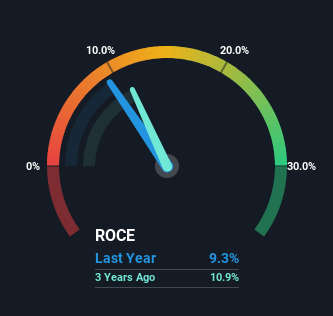Capital Allocation Trends At Aimflex Berhad (KLSE:AIMFLEX) Aren't Ideal
What are the early trends we should look for to identify a stock that could multiply in value over the long term? Firstly, we'd want to identify a growing return on capital employed (ROCE) and then alongside that, an ever-increasing base of capital employed. Put simply, these types of businesses are compounding machines, meaning they are continually reinvesting their earnings at ever-higher rates of return. Although, when we looked at Aimflex Berhad (KLSE:AIMFLEX), it didn't seem to tick all of these boxes.
Return On Capital Employed (ROCE): What Is It?
If you haven't worked with ROCE before, it measures the 'return' (pre-tax profit) a company generates from capital employed in its business. The formula for this calculation on Aimflex Berhad is:
Return on Capital Employed = Earnings Before Interest and Tax (EBIT) ÷ (Total Assets - Current Liabilities)
0.093 = RM12m ÷ (RM150m - RM17m) (Based on the trailing twelve months to June 2023).
Thus, Aimflex Berhad has an ROCE of 9.3%. Even though it's in line with the industry average of 9.3%, it's still a low return by itself.
Check out our latest analysis for Aimflex Berhad
Historical performance is a great place to start when researching a stock so above you can see the gauge for Aimflex Berhad's ROCE against it's prior returns. If you want to delve into the historical earnings, revenue and cash flow of Aimflex Berhad, check out these free graphs here.
How Are Returns Trending?
When we looked at the ROCE trend at Aimflex Berhad, we didn't gain much confidence. Around five years ago the returns on capital were 49%, but since then they've fallen to 9.3%. However it looks like Aimflex Berhad might be reinvesting for long term growth because while capital employed has increased, the company's sales haven't changed much in the last 12 months. It may take some time before the company starts to see any change in earnings from these investments.
On a side note, Aimflex Berhad has done well to pay down its current liabilities to 11% of total assets. That could partly explain why the ROCE has dropped. What's more, this can reduce some aspects of risk to the business because now the company's suppliers or short-term creditors are funding less of its operations. Since the business is basically funding more of its operations with it's own money, you could argue this has made the business less efficient at generating ROCE.
Our Take On Aimflex Berhad's ROCE
Bringing it all together, while we're somewhat encouraged by Aimflex Berhad's reinvestment in its own business, we're aware that returns are shrinking. And investors appear hesitant that the trends will pick up because the stock has fallen 13% in the last three years. In any case, the stock doesn't have these traits of a multi-bagger discussed above, so if that's what you're looking for, we think you'd have more luck elsewhere.
If you'd like to know about the risks facing Aimflex Berhad, we've discovered 2 warning signs that you should be aware of.
While Aimflex Berhad may not currently earn the highest returns, we've compiled a list of companies that currently earn more than 25% return on equity. Check out this free list here.
Have feedback on this article? Concerned about the content? Get in touch with us directly. Alternatively, email editorial-team (at) simplywallst.com.
This article by Simply Wall St is general in nature. We provide commentary based on historical data and analyst forecasts only using an unbiased methodology and our articles are not intended to be financial advice. It does not constitute a recommendation to buy or sell any stock, and does not take account of your objectives, or your financial situation. We aim to bring you long-term focused analysis driven by fundamental data. Note that our analysis may not factor in the latest price-sensitive company announcements or qualitative material. Simply Wall St has no position in any stocks mentioned.

